我们在项目中有时候会发现设置的变量没有生效,可能是被其它优先级高的变量给覆盖了。所以我们需要搞清楚SpringBoot的加载顺序。
Spring Boot属性加载顺序(优先级由高到底)
- 命令行参数
- SPRING APPLICATION_JSON属性
- ServletConfig初始化参数
- ServletContext初始化参数
- JNDI属性
- Java的系统属性,可以通过System.getProperties()获得的内容。例如java.runtime.name->Java? SE Runtime Environment、java.vm.version->25.191-b12
- 操作系统的环境变量-例如配置的M2_HOME -> D:\software\apache-maven-3.6.3、MYSQL_HOME -> D:\software\mysql-5.7.17-winx64等
- RandomValuePropertySource随机值属性
- jar包外的application-{profile}.properties/yml。properties优先级比yml高
- jar包内的application-{profile}.properties/yml。properties优先级比yml高
- jar包外的application.propertie/yml。properties优先级比yml高
- jar包内的application.properties/yml。properties优先级比yml高
- 通过@PropertySource指定xxx.properties注解定义的属性
- 默认属性(硬编码设置),使用SpringApplication.setDefaultProperties定义的内容
run方法
SpringBoot的run方法
public ConfigurableApplicationContext run(String... args) {
// 1、创建并启动计时监控类
StopWatch stopWatch = new StopWatch();
stopWatch.start();
// 2、初始化应用上下文和异常报告集合
ConfigurableApplicationContext context = null;
Collection<SpringBootExceptionReporter> exceptionReporters = new ArrayList<>();
// 3、设置系统属性 `java.awt.headless` 的值,默认值为:true
configureHeadlessProperty();
// 4、创建所有 Spring 运行监听器并发布应用启动事件
SpringApplicationRunListeners listeners = getRunListeners(args);
listeners.starting();
try {
// 5、 参数封装,也就是在命令行下启动应用带的参数,如--server.port=9000
ApplicationArguments applicationArguments = new DefaultApplicationArguments(
args);
// 6、根据运行监听器和应用参数来准备 Spring 环境(本文重点)
ConfigurableEnvironment environment = prepareEnvironment(listeners,
applicationArguments);
configureIgnoreBeanInfo(environment);
// 7、创建 Banner 打印类
Banner printedBanner = printBanner(environment);
// 8、创建应用上下文
context = createApplicationContext();
// 9、准备异常报告器
exceptionReporters = getSpringFactoriesInstances(
SpringBootExceptionReporter.class,
new Class[] { ConfigurableApplicationContext.class }, context);
// 10、准备应用上下文
prepareContext(context, environment, listeners, applicationArguments,
printedBanner);
// 11、刷新应用上下文
refreshContext(context);
// 12、应用上下文刷新后置处理
afterRefresh(context, applicationArguments);
// 13、停止计时监控类
stopWatch.stop();
// 14、输出日志记录执行主类名、时间信息
if (this.logStartupInfo) {
new StartupInfoLogger(this.mainApplicationClass)
.logStarted(getApplicationLog(), stopWatch);
}
// 15、发布应用上下文启动完成事件
listeners.started(context);
// 16、执行所有 Runner 运行器
callRunners(context, applicationArguments);
}
catch (Throwable ex) {
handleRunFailure(context, ex, exceptionReporters, listeners);
throw new IllegalStateException(ex);
}
try {
// 17、发布应用上下文就绪事件
listeners.running(context);
}
catch (Throwable ex) {
handleRunFailure(context, ex, exceptionReporters, null);
throw new IllegalStateException(ex);
}
// 18、返回应用上下文
return context;
}
prepareEnvironment
prepareEnvironment按字面意思就是准备环境,让我们看看他是怎么做的
// 准备环境
private ConfigurableEnvironment prepareEnvironment(
SpringApplicationRunListeners listeners,
ApplicationArguments applicationArguments) {
// Create and configure the environment 创建和配置环境
// 获取或创建环境
ConfigurableEnvironment environment = getOrCreateEnvironment();
// 配置环境:配置PropertySources和activeProfiles
configureEnvironment(environment, applicationArguments.getSourceArgs());
// listeners环境准备(就是广播ApplicationEnvironmentPreparedEvent事件)。还记得这个listeners怎么来的吗?
listeners.environmentPrepared(environment);
// 将环境绑定到SpringApplication
bindToSpringApplication(environment);
// 如果是非web环境,将环境转换成StandardEnvironment
if (this.webApplicationType == WebApplicationType.NONE) {
environment = new EnvironmentConverter(getClassLoader())
.convertToStandardEnvironmentIfNecessary(environment);
}
// 配置PropertySources对它自己的递归依赖
ConfigurationPropertySources.attach(environment);
return environment;
}
getOrCreateEnvironment
- 添加servletConfigInitParams属性集(ServletConfig初始化参数)
- 添加servletContextInitParams属性集(ServletContext初始化参数)
- 添加Jndi属性集
- 添加systemProperties属性集(Java的系统属性)
- 添加systemEnvironment属性集(操作系统环境变量)
判断当前的web环境,使用的是SERVLET,当前会实例化 StandardServletEnvironment
private ConfigurableEnvironment getOrCreateEnvironment() {
if (this.environment != null) {
return this.environment;
}
switch (this.webApplicationType) {
case SERVLET:
return new StandardServletEnvironment();
case REACTIVE:
return new StandardReactiveWebEnvironment();
default:
return new StandardEnvironment();
}
}
类关系StandardServletEnvironment->StandardEnvironment->AbstractEnvironment
父类AbstractEnvironment的构造器里面回退StandardServletEnvironment的customizePropertySources方法
StandardServletEnvironment中添加servletConfigInitParams属性集和servletContextInitParams属性集
@Override
protected void customizePropertySources(MutablePropertySources propertySources) {
propertySources.addLast(new StubPropertySource(SERVLET_CONFIG_PROPERTY_SOURCE_NAME));
propertySources.addLast(new StubPropertySource(SERVLET_CONTEXT_PROPERTY_SOURCE_NAME));
if (JndiLocatorDelegate.isDefaultJndiEnvironmentAvailable()) {
propertySources.addLast(new JndiPropertySource(JNDI_PROPERTY_SOURCE_NAME));
}
super.customizePropertySources(propertySources);
}
然后子类StandardEnvironment执行customizePropertySources方法.
添加systemProperties属性集和systemEnvironment属性集
@Override
protected void customizePropertySources(MutablePropertySources propertySources) {
propertySources.addLast(
new PropertiesPropertySource(SYSTEM_PROPERTIES_PROPERTY_SOURCE_NAME, getSystemProperties()));
propertySources.addLast(
new SystemEnvironmentPropertySource(SYSTEM_ENVIRONMENT_PROPERTY_SOURCE_NAME, getSystemEnvironment()));
}
configureEnvironment
- 添加defaultProperties属性集
- 添加commandLineArgs属性集(命令行参数)
protected void configureEnvironment(ConfigurableEnvironment environment, String[] args) {
if (this.addConversionService) {
ConversionService conversionService = ApplicationConversionService.getSharedInstance();
environment.setConversionService((ConfigurableConversionService) conversionService);
}
//在此应用程序的环境中添加、删除或重新排序任何 {@link PropertySource}。
configurePropertySources(environment, args);
//配置此应用程序环境中哪些配置文件处于活动状态 spring.profiles.active
configureProfiles(environment, args);
}
第一次进来this.defaultProperties为空,此时还没有添加默认属性集,commandLineArgs属性集并放到第一的位置
protected void configurePropertySources(ConfigurableEnvironment environment,
String[] args) {
MutablePropertySources sources = environment.getPropertySources();
// 此时defaultProperties还是null,可能后续过程会初始化,具体详情请期待后续的博文
if (this.defaultProperties != null && !this.defaultProperties.isEmpty()) {
// 存在的话将其放到最后位置
sources.addLast(
new MapPropertySource("defaultProperties", this.defaultProperties));
}
// 存在命令行参数,则解析它并封装进SimpleCommandLinePropertySource对象,同时将此对象放到sources的第一位置(优先级最高)
if (this.addCommandLineProperties && args.length > 0) {
String name = CommandLinePropertySource.COMMAND_LINE_PROPERTY_SOURCE_NAME;
if (sources.contains(name)) {
PropertySource<?> source = sources.get(name);
CompositePropertySource composite = new CompositePropertySource(name);
composite.addPropertySource(new SimpleCommandLinePropertySource(
"springApplicationCommandLineArgs", args));
composite.addPropertySource(source);
sources.replace(name, composite);
}
else {
// 将其放到第一位置
sources.addFirst(new SimpleCommandLinePropertySource(args));
}
}
}
listeners.environmentPrepared
- 添加spring_application_json属性集
- 添加vcap属性集
- 添加random属性集
- 添加application-profile.(properties/yml)属性集
通过广播器发布环境准备事件,对该事件感兴趣的监听器会做出处理
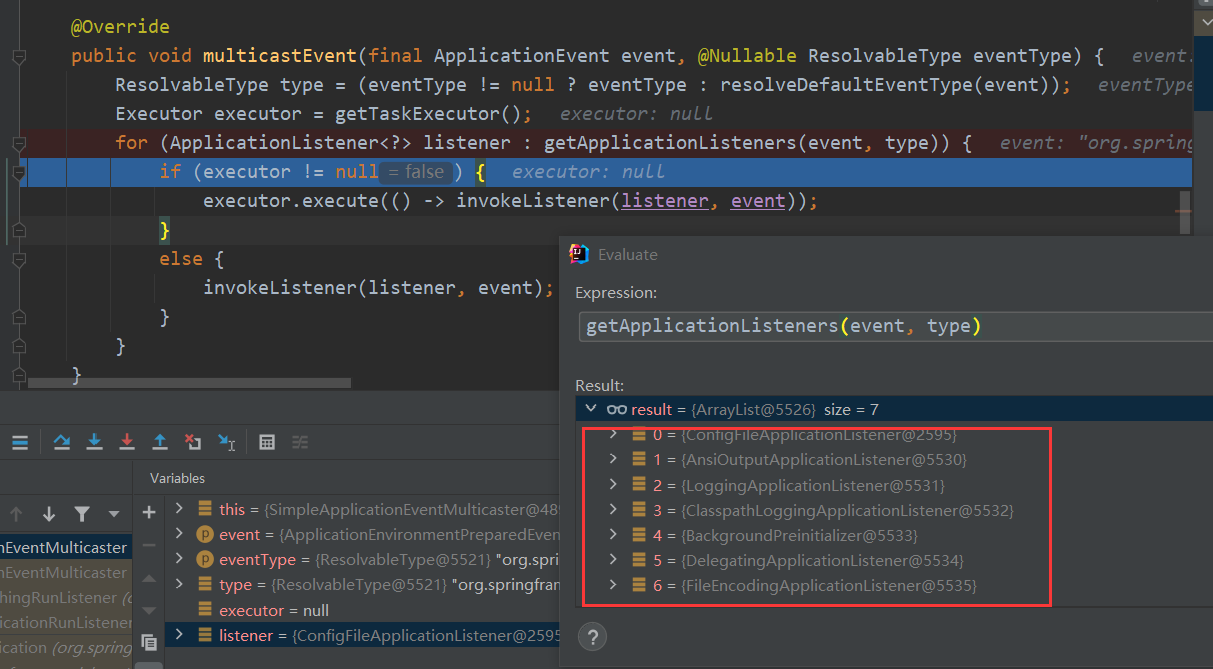
首先是ConfigFileApplicationListener监听器进行处理
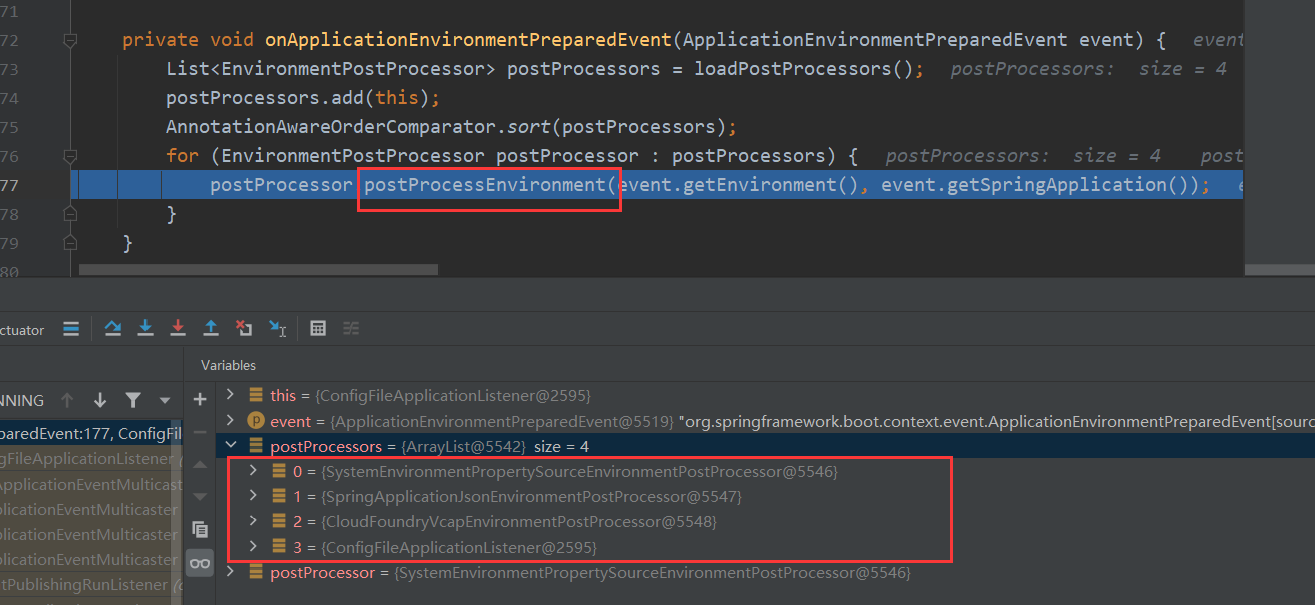
- 1、加载EnvironmentPostProcessor列表,仍然是从META-INF/spring.factories中加载(在SpringApplication实例化的时候已经加载了,这次是从缓存中读取),然后实例化;
- 2、将自己也加入EnvironmentPostProcessor列表;ConfigFileApplicationListener实现了EnvironmentPostProcessor接口,可以看它的类图。
- 3、对EnvironmentPostProcessor列表进行排序;排序之后,EnvironmentPostProcessor列表图如下
SystemEnvironmentPropertySourceEnvironmentPostProcessor
这里只是把systemEnvironment拿出来重新封装了下
@Override
public void postProcessEnvironment(ConfigurableEnvironment environment, SpringApplication application) {
String sourceName = StandardEnvironment.SYSTEM_ENVIRONMENT_PROPERTY_SOURCE_NAME;
PropertySource<?> propertySource = environment.getPropertySources().get(sourceName);
if (propertySource != null) {
replacePropertySource(environment, sourceName, propertySource);
}
}
@SuppressWarnings("unchecked")
private void replacePropertySource(ConfigurableEnvironment environment, String sourceName,
PropertySource<?> propertySource) {
Map<String, Object> originalSource = (Map<String, Object>) propertySource.getSource();
SystemEnvironmentPropertySource source = new OriginAwareSystemEnvironmentPropertySource(sourceName,
originalSource);
environment.getPropertySources().replace(sourceName, source);
}
SpringApplicationJsonEnvironmentPostProcessor
查找命令参数是否有SPRING_APPLICATION_JSON,如果有的话就会添加
例如:启动的时候设置参数

@Override
public void postProcessEnvironment(ConfigurableEnvironment environment, SpringApplication application) {
MutablePropertySources propertySources = environment.getPropertySources();
propertySources.stream().map(JsonPropertyValue::get).filter(Objects::nonNull).findFirst()
.ifPresent((v) -> processJson(environment, v));
}
private void processJson(ConfigurableEnvironment environment, JsonPropertyValue propertyValue) {
JsonParser parser = JsonParserFactory.getJsonParser();
Map<String, Object> map = parser.parseMap(propertyValue.getJson());
if (!map.isEmpty()) {
addJsonPropertySource(environment, new JsonPropertySource(propertyValue, flatten(map)));
}
}
它就会添加SPRING APPLICATION_JSON属性
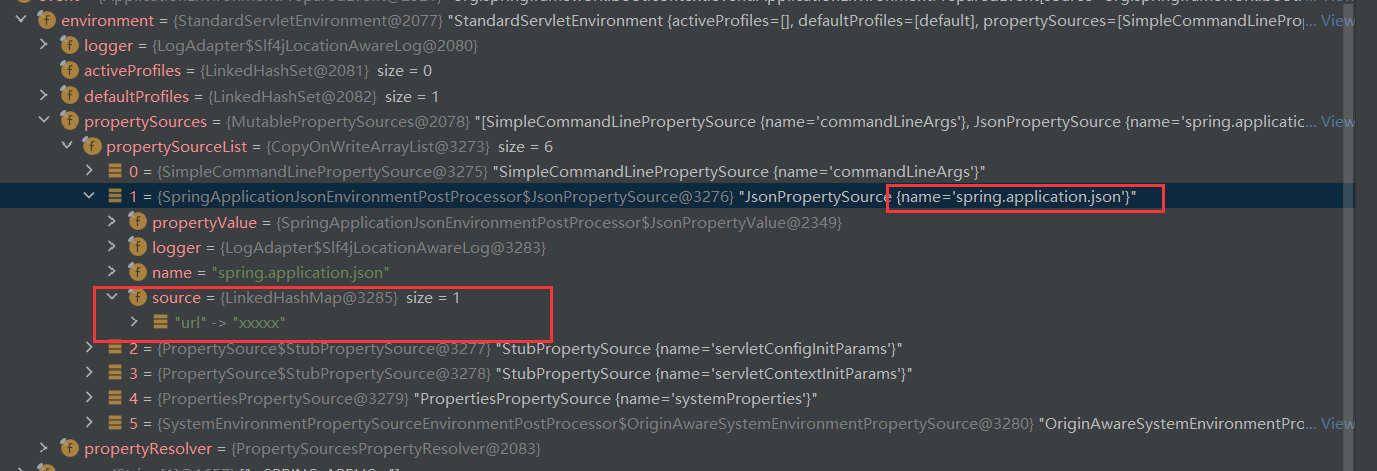
CloudFoundryVcapEnvironmentPostProcessor
spring-cloud环境在有用到,这里的话会直接跳过,不做处理
ConfigFileApplicationListener
- 添加一个随机的random属性集
- 初始化Profiles
protected void addPropertySources(ConfigurableEnvironment environment, ResourceLoader resourceLoader) {
//添加一个随机的random属性集
RandomValuePropertySource.addToEnvironment(environment);
//初始化Profiles
new Loader(environment, resourceLoader).load();
}
- 初始化PropertiesPropertySourceLoader和YamlPropertySourceLoader这两个加载器
- 从file:./config/,file:./,classpath:/config/,classpath:/路径下加载配置文件,PropertiesPropertySourceLoader加载配置文件application.xml和application.properties
new Loader(environment, resourceLoader).load();这个方法我们下面在细说
其它的监听器就不一一列举了
bindToSpringApplication
将获取到的environment中的spring.main配置绑定到SpringApplication的source中。
protected void bindToSpringApplication(ConfigurableEnvironment environment) {
try {
Binder.get(environment).bind("spring.main", Bindable.ofInstance(this));
}
catch (Exception ex) {
throw new IllegalStateException("Cannot bind to SpringApplication", ex);
}
}
ConfigurationPropertySources.attach(environment);
public static void attach(Environment environment) {
Assert.isInstanceOf(ConfigurableEnvironment.class, environment);
MutablePropertySources sources = ((ConfigurableEnvironment) environment).getPropertySources();
PropertySource<?> attached = sources.get(ATTACHED_PROPERTY_SOURCE_NAME);
if (attached != null && attached.getSource() != sources) {
sources.remove(ATTACHED_PROPERTY_SOURCE_NAME);
attached = null;
}
if (attached == null) {
sources.addFirst(new ConfigurationPropertySourcesPropertySource(ATTACHED_PROPERTY_SOURCE_NAME,
new SpringConfigurationPropertySources(sources)));
}
}
添加了一个configurationProperties名字的PropertySource

初始化Profiles
在application.properties里面有配置,并且创建了application-online.properties,application-online2.properties,application-online3.properties 文件
spring.profiles.active=online2
spring.profiles.include=online3
初始化Profiles的load方法
public void load() {
this.profiles = new LinkedList<>();
this.processedProfiles = new LinkedList<>();
this.activatedProfiles = false;
this.loaded = new LinkedHashMap<>();
initializeProfiles();
while (!this.profiles.isEmpty()) {
Profile profile = this.profiles.poll();
if (profile != null && !profile.isDefaultProfile()) {
addProfileToEnvironment(profile.getName());
}
load(profile, this::getPositiveProfileFilter, addToLoaded(MutablePropertySources::addLast, false));
this.processedProfiles.add(profile);
}
resetEnvironmentProfiles(this.processedProfiles);
load(null, this::getNegativeProfileFilter, addToLoaded(MutablePropertySources::addFirst, true));
addLoadedPropertySources();
}
initializeProfiles
- 1.profiles添加null
- 2.查找有没有指定spring.profiles.active或者spring.profiles.include的配置文件,这里是从启动参数上面查找例如
--spring.profiles.active=online - 3.从this.environment.getActiveProfiles()查找不是上一步获取到的属性
- 4.把第2步的放到profiles中
- 5.如果第2步中没有指定的话,profiles就用默认值:
spring.profiles.default,第2步中有值的话profiles就不会添加默认的
从这里我们知道如果application-default.properties和application-online.properties同时存在的话,如果spring.profiles.active指定了online那么application-default.properties就不会生效
private void initializeProfiles() {
// The default profile for these purposes is represented as null. We add it
// first so that it is processed first and has lowest priority.
this.profiles.add(null);
//看有没有配置spring.profiles.active和spring.profiles.include
Set<Profile> activatedViaProperty = getProfilesActivatedViaProperty();
//获取其他配置文件遍历集合添加到profiles中
this.profiles.addAll(getOtherActiveProfiles(activatedViaProperty));
// Any pre-existing active profiles set via property sources (e.g.
// System properties) take precedence over those added in config files.
addActiveProfiles(activatedViaProperty);
// 如果没有其它的配置的话添加null就是1,会进入方法中添加default配置
if (this.profiles.size() == 1) { // only has null profile
for (String defaultProfileName : this.environment.getDefaultProfiles()) {
Profile defaultProfile = new Profile(defaultProfileName, true);
this.profiles.add(defaultProfile);
}
}
}
getProfilesActivatedViaProperty
private Set<Profile> getProfilesActivatedViaProperty() {
// 假如环境中不存在ACTIVE_PROFILES_PROPERTY,INCLUDE_PROFILES_PROPERTY 则返回空集合
// spring.profiles.active ; spring.profiles.include
if (!this.environment.containsProperty(ACTIVE_PROFILES_PROPERTY)
&& !this.environment.containsProperty(INCLUDE_PROFILES_PROPERTY)) {
return Collections.emptySet();
}
// 从环境中获得INCLUDE_PROFILES_PROPERTY,ACTIVE_PROFILES_PROPERTY对应的值
// 处理并且返回
Binder binder = Binder.get(this.environment);
Set<Profile> activeProfiles = new LinkedHashSet<>();
activeProfiles.addAll(getProfiles(binder, INCLUDE_PROFILES_PROPERTY));
activeProfiles.addAll(getProfiles(binder, ACTIVE_PROFILES_PROPERTY));
return activeProfiles;
}
正常情况下如果没有配置的返回空集合了,如果需要往下走的话需要这样做。创建一个application-online.properties文件,然后在启动参数上面添加--spring.profiles.active=online在application.properties里面写是没有用的,因为这个时候application.properties里面的还没有被加载。如果不指定的话默认生效的文件就是application.properties/yml或者application-default.properties/yml

如果在添加了启动参数这里的activeProfiles就会有值

spring.profiles.include 的作用是可以同时让多个文件生效。
initializeProfiles方法执行完后,profiles会有两个值一个是null,一个是default
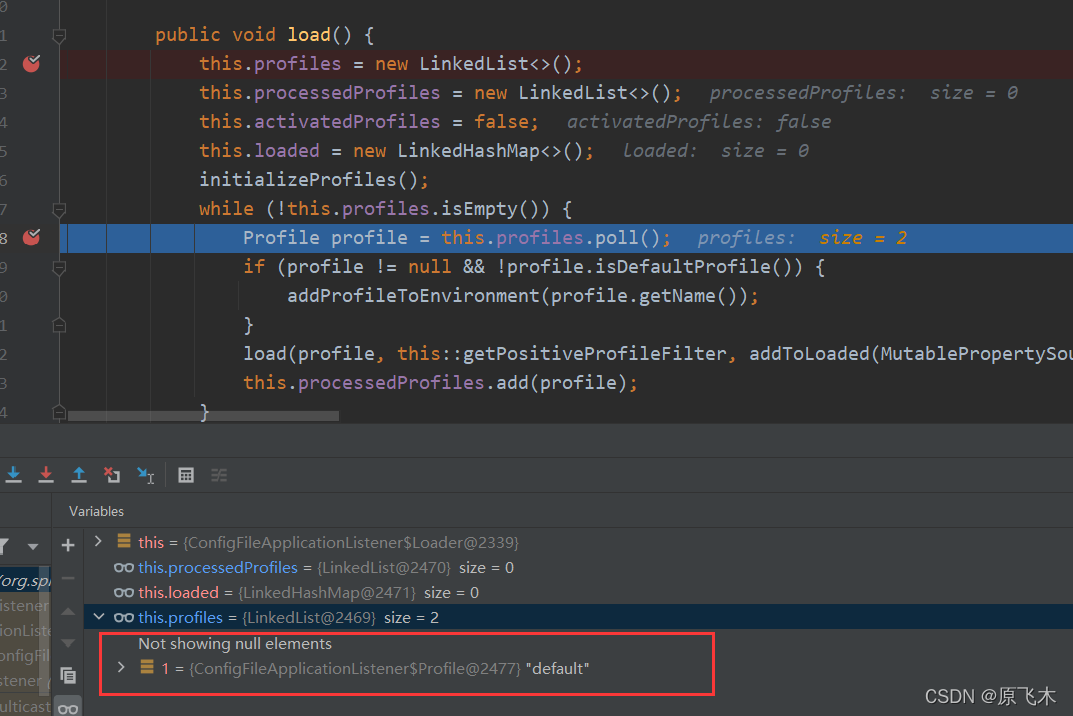
this.profiles.poll();弹出第一个为null,所以直接到load方法
load

getSearchLocations()是获取寻找的路径,如果不指定的话默认就是上面的四个路径,可以通过spring.config.location这个来配置其它的路径,默认的四个路径还是有的。
private Set<String> getSearchLocations() {
if (this.environment.containsProperty(CONFIG_LOCATION_PROPERTY)) {
return getSearchLocations(CONFIG_LOCATION_PROPERTY);
}
Set<String> locations = getSearchLocations(CONFIG_ADDITIONAL_LOCATION_PROPERTY);
//使用默认的加载路径
locations.addAll(
asResolvedSet(ConfigFileApplicationListener.this.searchLocations, DEFAULT_SEARCH_LOCATIONS));
return locations;
}
getSearchNames()这里就是要找以什么开头的文件比如说默认的是以application…开头的文件,如果要配置以其它开头的话可以通过spring.config.name属性来配置。一般也不会去修改。
private Set<String> getSearchNames() {
if (this.environment.containsProperty(CONFIG_NAME_PROPERTY)) {
String property = this.environment.getProperty(CONFIG_NAME_PROPERTY);
return asResolvedSet(property, null);
}
//使用默认application开头的配置文件
return asResolvedSet(ConfigFileApplicationListener.this.names, DEFAULT_NAMES);
}
回到上面加载了四个默认的路径然后执行load方法,由于name=application所以会执行下面的loadForFileExtension方法。
这里this.propertySourceLoaders有两个值,然后遍历执行
- PropertiesPropertySourceLoader(看代码可以知道它主要是读取properties和xml结尾的文件)
- YamlPropertySourceLoader(看代码可以知道它主要是读取yml和yaml结尾的文件)
private void load(String location, String name, Profile profile, DocumentFilterFactory filterFactory,
DocumentConsumer consumer) {
if (!StringUtils.hasText(name)) {
for (PropertySourceLoader loader : this.propertySourceLoaders) {
if (canLoadFileExtension(loader, location)) {
load(loader, location, profile, filterFactory.getDocumentFilter(profile), consumer);
return;
}
}
}
Set<String> processed = new HashSet<>();
for (PropertySourceLoader loader : this.propertySourceLoaders) {
for (String fileExtension : loader.getFileExtensions()) {
if (processed.add(fileExtension)) {
loadForFileExtension(loader, location + name, "." + fileExtension, profile, filterFactory,
consumer);
}
}
}
}
loadForFileExtension
根据profile的值来判断,如果为空的话,就会去读取路径下的application.properties,如果profile=online的话就会去读取application-online.properties。类似这样
private void loadForFileExtension(PropertySourceLoader loader, String prefix, String fileExtension,
Profile profile, DocumentFilterFactory filterFactory, DocumentConsumer consumer) {
DocumentFilter defaultFilter = filterFactory.getDocumentFilter(null);
DocumentFilter profileFilter = filterFactory.getDocumentFilter(profile);
if (profile != null) {
// Try profile-specific file & profile section in profile file (gh-340)
String profileSpecificFile = prefix + "-" + profile + fileExtension;
load(loader, profileSpecificFile, profile, defaultFilter, consumer);
load(loader, profileSpecificFile, profile, profileFilter, consumer);
// Try profile specific sections in files we've already processed
for (Profile processedProfile : this.processedProfiles) {
if (processedProfile != null) {
String previouslyLoaded = prefix + "-" + processedProfile + fileExtension;
load(loader, previouslyLoaded, profile, profileFilter, consumer);
}
}
}
// Also try the profile-specific section (if any) of the normal file
load(loader, prefix + fileExtension, profile, profileFilter, consumer);
}
让我们看看这个load方法,先判断文件是否存在的一些前置判断。如果配置文件里面有spring.profiles.active,会把它的值放到this.profiles去加载相应对应的配置文件。然后会把application-default.properties给取消了
private void load(PropertySourceLoader loader, String location, Profile profile, DocumentFilter filter,
DocumentConsumer consumer) {
try {
Resource resource = this.resourceLoader.getResource(location);
if (resource == null || !resource.exists()) {
if (this.logger.isTraceEnabled()) {
StringBuilder description = getDescription("Skipped missing config ", location, resource,
profile);
this.logger.trace(description);
}
return;
}
if (!StringUtils.hasText(StringUtils.getFilenameExtension(resource.getFilename()))) {
if (this.logger.isTraceEnabled()) {
StringBuilder description = getDescription("Skipped empty config extension ", location,
resource, profile);
this.logger.trace(description);
}
return;
}
String name = "applicationConfig: [" + location + "]";
//加载配置文件,如果里面的属性spring.profiles.active或者spring.profiles.include进行处理,看下面的图
List<Document> documents = loadDocuments(loader, name, resource);
if (CollectionUtils.isEmpty(documents)) {
if (this.logger.isTraceEnabled()) {
StringBuilder description = getDescription("Skipped unloaded config ", location, resource,
profile);
this.logger.trace(description);
}
return;
}
List<Document> loaded = new ArrayList<>();
for (Document document : documents) {
if (filter.match(document)) {
//this.profiles添加spring.profiles.active属性并移除默认属性default
addActiveProfiles(document.getActiveProfiles());
//this.profiles添加spring.profiles.include属性
addIncludedProfiles(document.getIncludeProfiles());
loaded.add(document);
}
}
Collections.reverse(loaded);
if (!loaded.isEmpty()) {
loaded.forEach((document) -> consumer.accept(profile, document));
if (this.logger.isDebugEnabled()) {
StringBuilder description = getDescription("Loaded config file ", location, resource, profile);
this.logger.debug(description);
}
}
}
catch (Exception ex) {
throw new IllegalStateException("Failed to load property " + "source from location '" + location + "'",
ex);
}
}

this.profiles第一个变量null走完后,出来就变成online2和online3了,并且default不见了。接下去就是和上面一样的步骤了
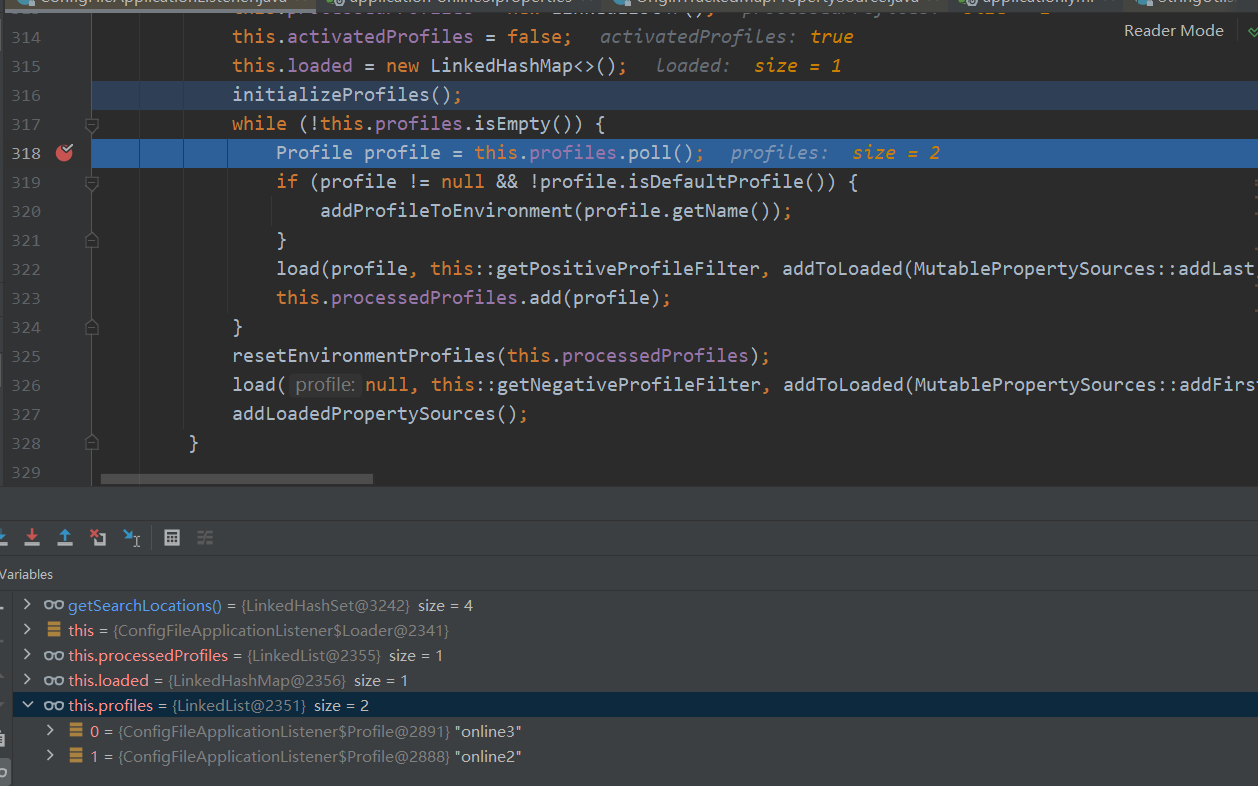
resetEnvironmentProfiles
确保Environment 中活动配置文件的顺序与处理配置文件的顺序相匹配。
private void resetEnvironmentProfiles(List<Profile> processedProfiles) {
String[] names = processedProfiles.stream()
.filter((profile) -> profile != null && !profile.isDefaultProfile()).map(Profile::getName)
.toArray(String[]::new);
this.environment.setActiveProfiles(names);
}
load
这个load是防止没有进入循环的时候再去加载一次application.properties/yml
addLoadedPropertySources
添加加载的属性源
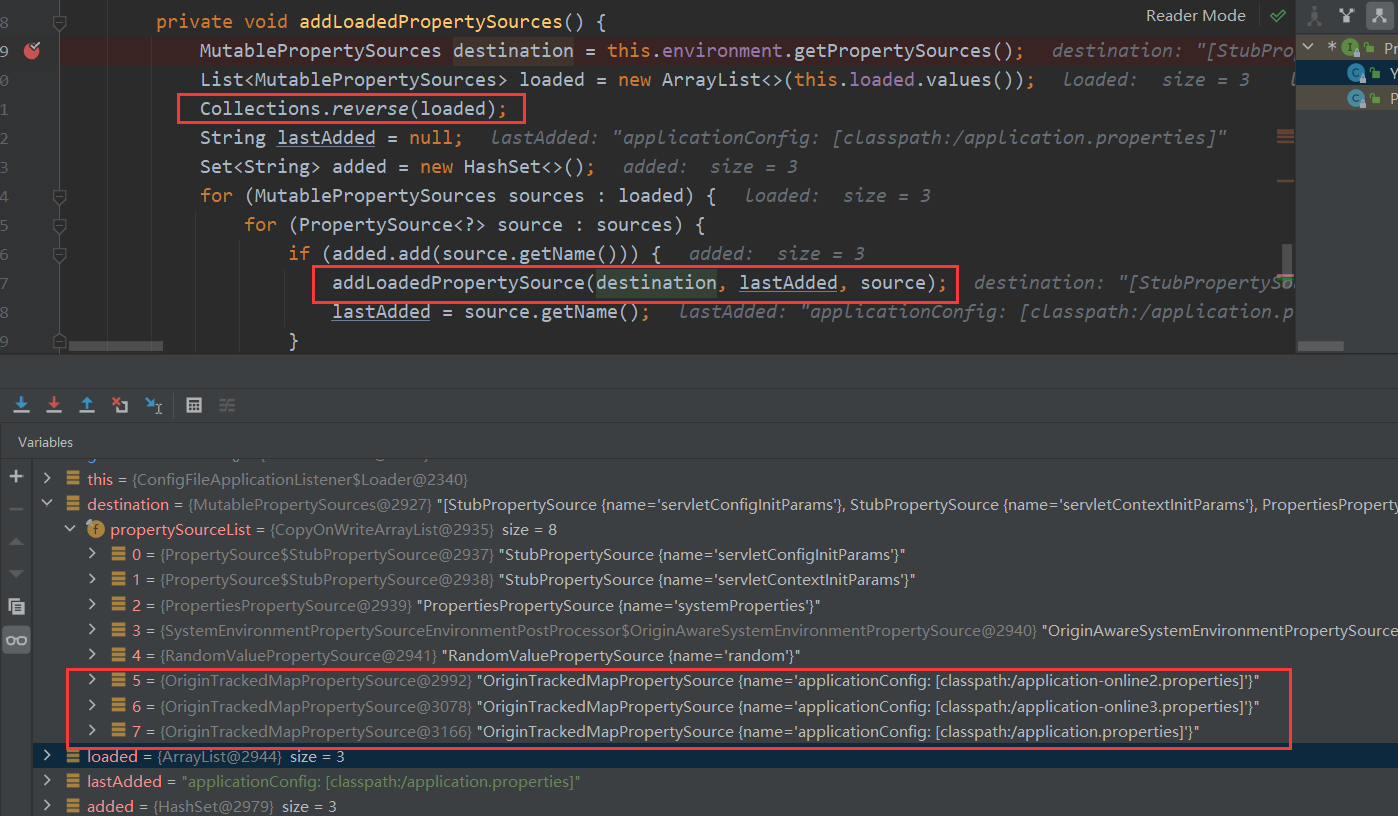
变量覆盖的问题
在application.properties引入了两个文件并且设置了一个变量
spring.profiles.active=online2
spring.profiles.include=online3
test.name=application
application-online2.properties中
test.name=online2
application-online3.properties中
test.name=online3
三个文件中都有test.name,按照上面图的顺序,越上面的优先级越高
所以最后test.name的值为online2。测试结果也是这样
为什么是spring.profiles.active中的变量生效呢
执行完addActiveProfiles后this.profiles中会添加online的属性
但是执行addIncludedProfiles会先清空先放include中的online3的属性
for (Document document : documents) {
if (filter.match(document)) {
addActiveProfiles(document.getActiveProfiles());
addIncludedProfiles(document.getIncludeProfiles());
loaded.add(document);
}
}
private void addIncludedProfiles(Set<Profile> includeProfiles) {
LinkedList<Profile> existingProfiles = new LinkedList<>(this.profiles);
this.profiles.clear();
this.profiles.addAll(includeProfiles);
this.profiles.removeAll(this.processedProfiles);
this.profiles.addAll(existingProfiles);
}
- this.profiles的第一个值为null,在遍历执行的时候第一个加入的就是application.properties
- 变量完null后又往里面添加了online3和online2所以就是下面图的顺序
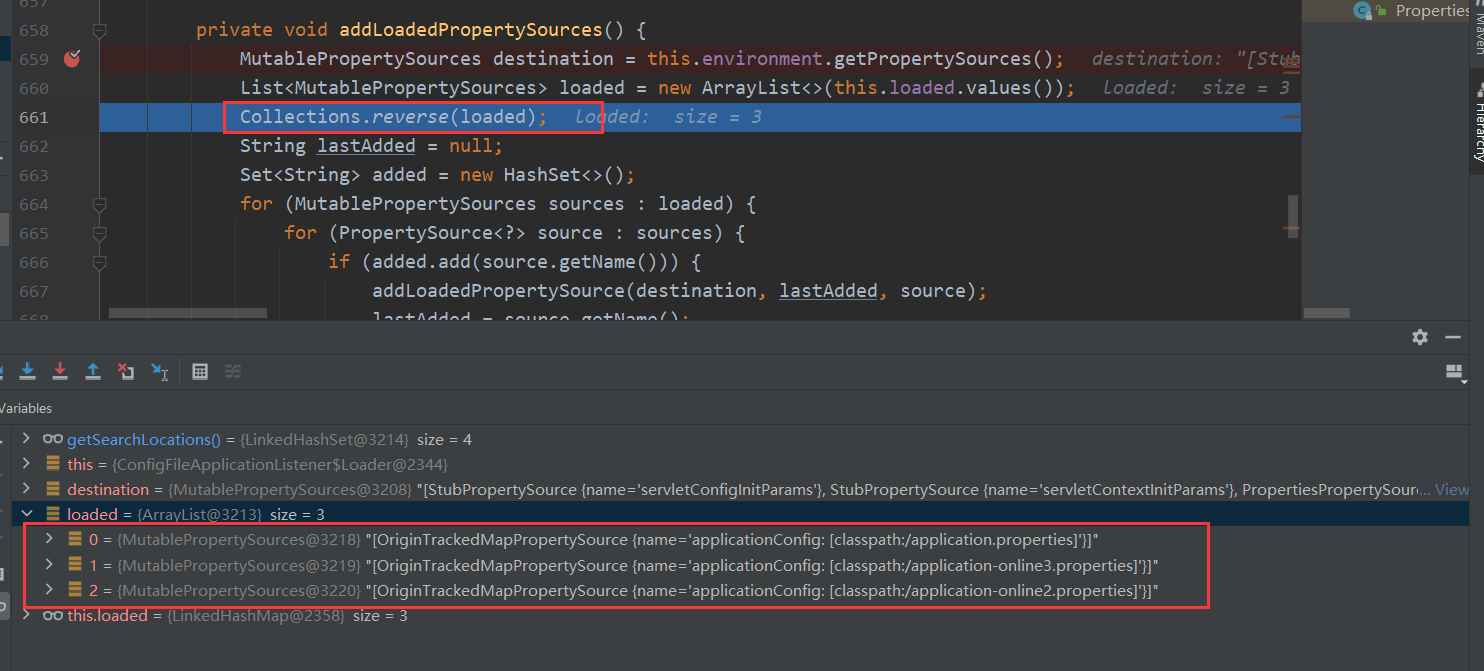
然后执行反转下就是优先级了所以test.name的值为online2